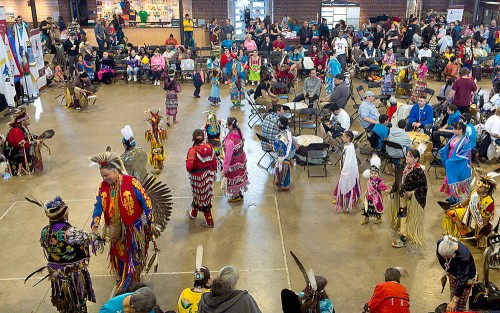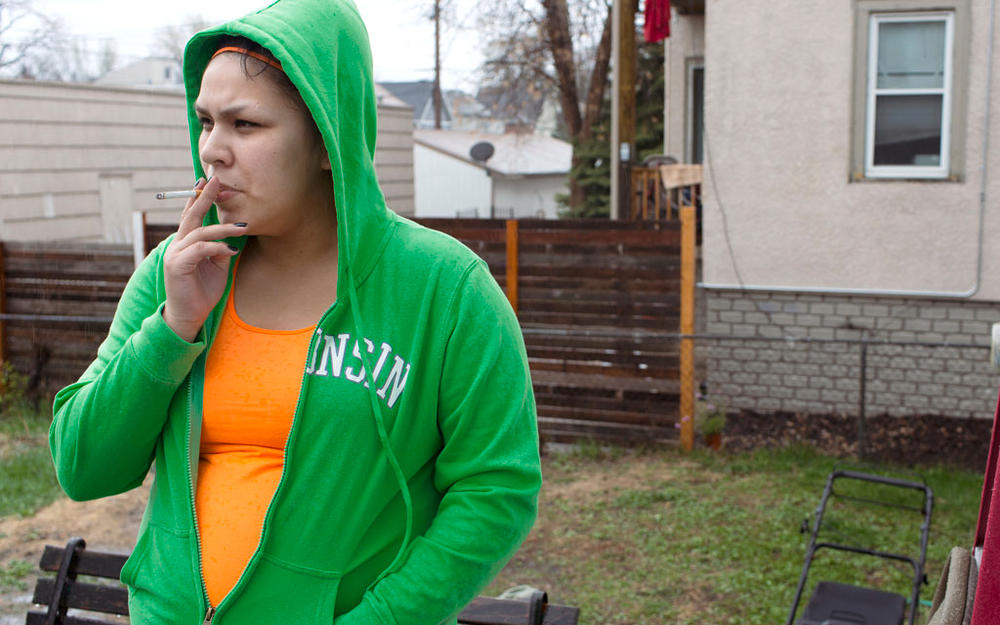By Lorna Benson, Minnesota Public Radio News on Jul 8, 2014 at 2:31 p.m.

Minneapolis – Inside the cavernous Base Camp facility at Fort Snelling, a long line of cancer survivors made a slow procession around the perimeter of the former cavalry drill hall where a century ago Army troops trained their horses. Their presence at a gathering of American Indians is solemn, supportive and startling.
“A lot of survivors,” an MC announced over a drumbeat. “So survivors come on out.”
Cancer has devastated Minnesota’s American Indian population, stripping families of breadwinners and robbing children of their parents and grandparents.
Nowhere is the scale of the problem more evident than the annual spring Powwow for Hope, where dancers dressed in vibrant traditional costumes escorted the survivors until their line morphed into a vast circle.
Overhead a projector cycled through dozens of photographs and names of American Indians who have lost their cancer battles in the past year. The tribute also included stories of hope and cancer remission.
Among the cancer survivors whose picture flashed on the screen was Robert DesJarlait, a 67-year-old member of the Red Lake Band of Chippewa. Ten months earlier, doctors removed a cancerous tumor from his colon.
“It’s kind of ironic that I was at this powwow last year and didn’t know for sure that I officially had cancer,” he said.
When it comes to cancer — Minnesota’s number one cause of death — American Indians are almost always on the wrong end of the state’s data on the health disparity that exists between whites and minorities.
Their risk of dying from lung cancer is more than two times higher than it is among non-Hispanic whites. Their rates of cervical and larynx cancer are four times higher.
American Indians also have the state’s highest rates of colorectal, kidney and oral cancers.
While the statistics are grim, they are not immutable. Striking new research has revealed that more than half of the state’s American Indians smoke. Their smoking rate is so high it likely explains much of their excess cancer burden.
The stark data are making it easier for some native people to question their community’s complicated relationship with tobacco. The research is also providing much-needed direction on where native people can most effectively focus their cancer-fighting efforts.
DesJarlait, a visual artist, is among those who have changed their lifestyles.
During a break in the program DesJarlait said he considers himself fortunate. His cancer was detected at an early stage and his treatment has been successful. After being weakened by the disease and treatment, he felt strong enough to dance at this year’s powwow.
One of the biggest lifestyle changes he made was quitting tobacco. He switched to electronic cigarettes after his doctor warned him that his cancer could return, if he didn’t quit his two-pack-a-day smoking habit.
“And I said, ‘You mean smoking caused the tumor in my colon?’ And she said, ‘Yes, well it’s one of the factors.'”
While there are many potential causes of cancer — from genetics to poor diet and lack of exercise — tobacco use is strongly related to the cancers that most affect Minnesota’s native people.
“We can’t talk about cancer in American Indian communities without addressing the high rates of tobacco and the rates of second-hand smoke exposure in our communities,” said Kris Rhodes, a member of the Bad River Band of Lake Superior Chippewa and executive director of the American Indian Cancer Foundation. The non-profit organization sponsors the Powwow for Hope and is one of the community’s biggest voices in urging Indian people to quit smoking.
A recent tribal tobacco use survey found that 59 percent of Minnesota’s native people smoke. Nearly 3,000 people completed the questionnaire, making it the largest tobacco survey ever conducted among American Indians in Minnesota.
Jean Forster, co-author of a report on the survey, said a 59 percent smoking rate is “an unbelievable number” because it is nearly four times higher than Minnesota’s overall adult smoking rate of 16 percent.
“Fifty-nine percent means that most people smoke, most adults smoke. Most kids see that most adults smoke,” she said. “It’s a normative behavior for those communities.”
The survey wasn’t designed to reveal why the smoking rate is so high in American Indian communities.
But Forster, a University of Minnesota epidemiologist, said it’s obvious that Minnesota’s anti-smoking campaigns have either failed to reach native people, or have had little effect on them.
“What we’re doing for the population just is not working,” she said. “This is the same smoking rate that the population as a whole experienced at its peak in the ’60s.”
By that measure, Forster said, it could take decades for American Indians to change their minds about smoking.
A few days before Mother’s Day, 24-year-old Ricki LaMorie of Hayward, Wis., grabbed her pack of cigarettes and headed toward the back porch of her grandmother’s Minneapolis home.
“I’m gonna go smoke my cigarette,” she said. “That sounds bad.”

Her grandmother, Margie LaMorie, objects to her smoking habit, but understands how hard it is to quit. LaMorrie, 75, has been a smoker for over six decades. She started smoking before she was even in her teens.
“My grandma bought me my first pack of cigarettes when I was 11,” she said. “So I had to go to the neighbor kids to teach me how, because she thought I was sneaking, and I wasn’t sneaking.”
LaMorie’s grandmother did ask her to follow a few smoking rules. But they were designed to prevent the 11-year-old from burning down her family’s outhouse, or possibly even their home, on the Lac Courte Oreilles Indian Reservation in northern Wisconsin.
“There was no smoking before breakfast in the morning,” she recalled. “There was no smoking after dinner. There was no smoking upstairs. There was no smoking by oneself without someone paying attention.”
LaMorie said no one in her community knew anything about smoking’s link to cancer back then. It was just something that everyone seemed to be doing and it made her feel grown-up and glamorous.
She still smokes and is not sure why she hasn’t quit. Even her colon cancer diagnosis a few years ago wasn’t enough of an incentive.
Still, LaMorie believes anyone can quit — if they want to.
“Some days I can go without any until someone will come along and, ‘Oh I’m gonna go sit out. Oh, I’ll go join you,'” she said. “For me it’s a social thing.”
Jackie Dionne, the American Indian Health director at the Minnesota Department of Health, has heard that many times before.
“It’s just so commonly accepted, that it’s, ‘Yeah, I know these are going to kill me, but I’m going to smoke anyway,'” said Dionne, a member of the Turtle Mountain Chippewa Tribe and a former smoker. “It’s just that ’cause everybody else is smoking.
“We have to really go through a social change like the state did in the mid-’80s when people stopped smoking and then didn’t want to be around people who did smoke,” she said. “And so then it becomes socially unacceptable.”
Dionne said anti-tobacco advocates don’t fully understand the reasons why native people smoke. In part, she said, that explains why anti-tobacco strategies that have worked well in the general population have not been particularly effective in the American Indian community.
A Health Department report released in February attributed health disparities in American Indian communities to government efforts to uproot them from their land and destroy their way of life. The report concluded that the displacement has led to high rates of unemployment, poverty and high-risk behaviors among native people.
Smoking, Dionne said, is a coping mechanism for many American Indians.
“You have trauma that is generational, you know, my grandma, my mom and then me,” she said. “Highly traumatized people and populations tend to report higher levels of depression and anxiety. And when you’re reporting higher levels of depression and anxiety in a population, nicotine is one of those drugs that will relieve it almost immediately.”
The use of ceremonial tobacco may be another factor that has influenced American Indian smoking rates.
Tobacco is considered a sacred medicine given by the Creator, said Rhodes, of the American Indian Cancer Foundation. Tobacco is used regularly in ceremonies, but it also is common for American Indians to use leaves from other plants. On occasion, herbs are burned in a vessel.
However, she said there has been some debate within the community about whether it is appropriate to translate that spiritual meaning to smoking commercial tobacco.
Rhodes said it has also been challenging to send a strong message about the ills of commercial tobacco when it affects the livelihoods of so many people. In the age of the Indian casino, cigarette sales are an important part of the tribal economy. They have helped impoverished tribes build new roads and schools.
“Those of us that work in tobacco control in tribal communities know that the economics associated with tobacco in our tribal communities are really sensitive issues,” she said.
To a certain degree, American Indians already know what they need to do to reduce the terrible toll that cancer has taken on their communities. Better data has revealed that reducing the smoking rate is an obvious start. But it will be a complicated journey.
Some native leaders acknowledge feeling a bit overwhelmed by the task.
But in the same breath, they’re optimistic — they’ve noticed many more people talking about the link between smoking and cancer in the months since the tobacco use report was released. That, they say, is a good start.
